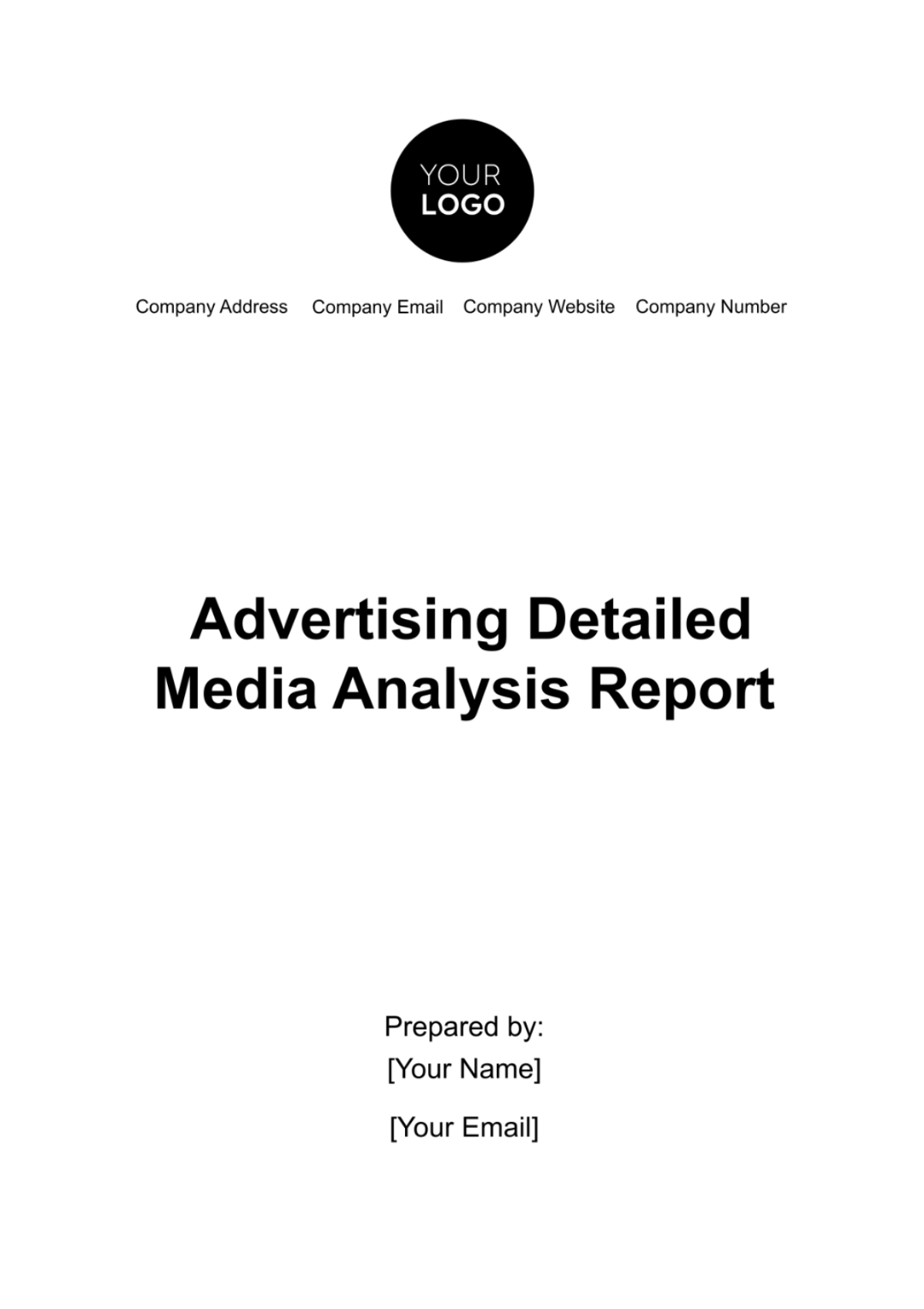Free Advertising Detailed Media Analysis Report

I. Executive Summary
In this comprehensive report, we delve into the multifaceted world of advertising media, offering a thorough analysis tailored for [Your Company Name]. The primary objective is to scrutinize and evaluate the performance and impact of various advertising channels that the company has employed throughout the year 2050. This analysis is pivotal in strategizing future media planning and buying, ensuring an optimal allocation of resources and maximized returns.
Our approach involves a detailed examination of key performance indicators (KPIs) across multiple media platforms. These KPIs include, but are not limited to, audience reach, impressions, engagement rates, click-through rates (CTR), and overall consumer response. By analyzing these metrics, we gain valuable insights into how each media channel contributes to our advertising objectives, and more importantly, how they resonate with our target audience.
An essential part of this report is the Return on Investment (ROI) analysis. We meticulously calculate the ROI for each media channel, considering the total spend against the revenue generated. This analysis not only highlights the most profitable channels but also uncovers potential areas of underperformance, guiding us in making more informed decisions about future investments.
Furthermore, we explore audience engagement metrics, which are crucial in understanding how effectively our content connects with the audience. Engagement rates on platforms like social media and online advertising offer a direct glimpse into consumer behavior and preferences. These insights are instrumental in tailoring our content to better align with audience expectations and trends.
In addition to quantitative data, this report also provides qualitative assessments, drawing on market trends, consumer behavior studies, and competitive analyses. This comprehensive approach ensures that [Your Company Name] is not only guided by hard data but also by a nuanced understanding of the ever-evolving advertising landscape.
Ultimately, the insights garnered from this report are intended to steer [Your Company Name] towards more strategic, data-driven decisions in its advertising efforts. By aligning our media choices with proven performance metrics and market trends, we can ensure that every advertising dollar is spent effectively, thus driving better business outcomes and enhancing brand presence in the competitive market.
II. Media Spend Overview
The Media Spend Overview for [Your Company Name] in 2050 offers a comprehensive breakdown of the company’s investment across various advertising channels which is presented in the chart and table below:
Media Channel | Q1 Spend | Q2 Spend | Q3 Spend | Q4 Spend | Total Spend |
Television | $500,000 | $550,000 | $600,000 | $650,000 | $2,300,000 |
Online Advertising | $300,000 | $320,000 | $340,000 | $360,000 | $1,320,000 |
Social Media | $200,000 | $210,000 | $220,000 | $230,000 | $860,000 |
Print Media | $100,000 | $105,000 | $110,000 | $115,000 | $430,000 |
Outdoor Advertising | $150,000 | $155,000 | $160,000 | $165,000 | $630,000 |
Total | $1,250,000 | $1,340,000 | $1,430,000 | $1,520,000 | $5,540,000 |
A. Television Advertising
Television remains a significant channel for [Your Company Name], with a steady increase in spend across all quarters. This consistent investment reflects television's broad reach and effectiveness in building brand awareness. The gradual increase in budget allocation each quarter indicates an adaptive strategy in response to audience ratings and seasonal programming, maximizing impact during peak viewing times.
B. Online Advertising
Online advertising saw a consistent upward trend in investment throughout the year. This channel's versatility and the ability to target specific demographics make it a valuable tool for more personalized marketing campaigns. The increase in spending each quarter suggests an ongoing effort to refine digital strategies and leverage data analytics for more effective ad placements.
C. Social Media
Social media's budget allocation underscores its growing importance in the digital landscape. The platform offers unique opportunities for engagement, brand building, and direct customer interaction. The incremental increase in spend indicates an evolving approach, likely incorporating new platforms and innovative content strategies to stay relevant and engaging.
D. Print Media
Despite the digital shift, print media maintains a niche yet significant role in the advertising mix. The relatively stable quarterly spend reflects a targeted approach, likely focusing on specific publications that align with the company's core audience or industry.
E. Outdoor Advertising
Outdoor advertising, encompassing billboards, transit ads, and other out-of-home media, receives a steady portion of the budget. This form of advertising is key for sustained visibility in high-traffic areas, complementing other media channels in creating a holistic brand presence.
The allocation of funds across these channels is not arbitrary but rather a reflection of a strategic approach tailored to the company’s goals. The variances in quarterly spending are indicative of a dynamic marketing strategy that responds to market trends, consumer behavior shifts, and seasonal opportunities.
This overview not only illustrates the company’s commitment to a diversified media strategy but also sets the stage for analyzing the effectiveness of these investments in subsequent chapters, particularly in terms of ROI and audience engagement. The data presented here will be crucial for future budget planning, ensuring that [Your Company Name] continues to allocate resources in a manner that maximizes advertising impact and drives business growth.
III. Audience Reach and Engagement
The Audience Reach and Engagement section provides a critical analysis of how different media channels have performed in terms of capturing and engaging with the audience in 2050. The following table, offers a clear overview of each channel's effectiveness in connecting with and influencing the target audience:
Media Channel | Impressions | Engagement Rate | Click-Through Rate (CTR) |
Television | 12,500,000 | 4.5% | N/A |
Online Advertising | 8,000,000 | 3.0% | 1.8% |
Social Media | 15,000,000 | 6.0% | 2.2% |
Print Media | 5,500,000 | 2.5% | N/A |
Outdoor Advertising | 7,000,000 | 3.5% | N/A |
A. Television
Television continues to be a powerful medium for reaching a broad audience, as evidenced by its impressive 12.5 million impressions. The engagement rate of 4.5% signifies the medium's strength in maintaining viewer attention, likely due to high-quality content and strategic ad placements during peak viewing times. However, the lack of a direct click-through rate (CTR) points to its limitations in immediate consumer action.
B. Online Advertising
Online advertising, with 8.0 million impressions, demonstrates a strong presence in the digital space. The engagement rate, while slightly lower than television, is complemented by a CTR of 1.8%. This shows that online ads not only capture attention but also encourage viewers to take action, a key metric in the digital advertising sphere.
C. Social Media
Social media stands out as the most engaging channel with the highest engagement rate of 6.0% and a CTR of 2.2%. These figures underscore the platform's effectiveness in creating interactive and compelling content that resonates with the audience. The impressive number of impressions indicates a wide reach, tapping into a diverse and active online community.
D. Print Media
Print media, with 5.5 million impressions and a 2.5% engagement rate, shows its continued relevance, especially in niche markets and among specific demographics. While it lacks the interactivity of digital mediums, its engagement rate suggests a loyal and dedicated readership, valuing the tangibility and credibility of printed material.
E. Outdoor Advertising
Outdoor advertising achieves a notable 7.0 million impressions, with an engagement rate of 3.5%. These figures reflect the medium's ability to capture attention in high-traffic areas. While it does not offer direct metrics like CTR, its visual impact is undeniable, serving as a constant reminder of the brand in public spaces.
Each channel offers unique strengths – television and outdoor advertising excel in wide-reaching impressions, while digital channels like online advertising and social media provide interactive and measurable engagement opportunities. Print media, despite the digital shift, maintains a valuable position in reaching specific audience segments.
This comprehensive understanding of audience metrics across various channels is crucial for [Your Company Name] in refining its advertising strategies to maximize both reach and engagement. It allows for a more targeted approach, ensuring that the right message reaches the right audience through the most effective channel.
IV. Return on Investment (ROI) Analysis
The Return on Investment (ROI) Analysis chapter is a critical component of the report, offering a detailed assessment of the financial returns generated by each media channel in 2050. The following table provides insights into the profitability and efficiency of the advertising spend across different platforms:
Media Channel | Revenue Generated | ROI |
Television | $4,500,000 | 195.6% |
Online Advertising | $2,600,000 | 197.0% |
Social Media | $2,000,000 | 232.6% |
Print Media | $850,000 | 197.7% |
Outdoor Advertising | $1,200,000 | 190.5% |
A. Television
Television advertising has yielded an impressive ROI of 195.6%, generating $4,500,000 in revenue. This high return reflects television's expansive reach and its effectiveness in influencing a broad audience. The substantial revenue generated indicates successful ad campaigns, likely due to strategic placement, high-quality production, and alignment with viewer preferences.
B. Online Advertising
Online advertising, with an ROI of 197.0%, demonstrates its effectiveness in the digital realm. Generating $2,600,000 in revenue, this channel benefits from its ability to target specific demographics and track user interaction directly. The high ROI suggests that the digital campaigns were well-optimized, leveraging data analytics to maximize conversion rates.
C. Social Media
Social media stands out with the highest ROI of 232.6%, translating to $2,000,000 in revenue. This extraordinary return is indicative of the platform's powerful engagement capabilities and its ability to foster direct relationships with consumers. The success here is likely due to innovative content strategies, influencer partnerships, and targeted advertising.
D. Print Media
Print media continues to be a viable advertising channel, as evidenced by its ROI of 197.7% and revenue of $850,000. This robust performance can be attributed to its targeted approach, credibility, and appeal to specific audience segments who value print media.
E. Outdoor Advertising
Outdoor advertising, with an ROI of 190.5%, generating $1,200,000 in revenue, showcases its enduring effectiveness. Its constant visibility in public spaces makes it a significant contributor to brand awareness and recall, complementing other advertising channels.
The ROI analysis reveals that each media channel has distinct strengths in terms of revenue generation and efficiency of advertising spend. Television and print media, despite being traditional formats, demonstrate strong financial returns, affirming their relevance in the current advertising landscape. Online advertising and social media, with their digital prowess, deliver high ROIs, highlighting the importance of digital strategies in modern marketing. Outdoor advertising, with its consistent performance, underscores the value of physical brand presence.
These insights are invaluable in guiding future advertising investments. They emphasize the need for a balanced, multi-channel strategy that leverages both traditional and digital mediums to optimize overall advertising effectiveness. By understanding the ROI of each channel, the company can make data-driven decisions, allocating resources to the most profitable channels while exploring ways to enhance performance in less efficient areas. This strategic approach will ensure that advertising efforts are not only creatively compelling but also financially prudent, driving sustainable business growth.
V. Conclusions and Recommendations
A. Conclusions
Our analysis indicates that a balanced approach with a focus on high ROI channels like Social Media and Online Advertising can significantly enhance the overall effectiveness of our advertising campaigns.
B. Recommendations
Based on the data, we recommend increasing the budget allocation for Social Media due to its high engagement rate and ROI. Additionally, Online Advertising shows potential for growth, particularly in targeting specific demographics.
This report should be reviewed and updated annually to align with changing market trends and consumer behaviors.
- 100% Customizable, free editor
- Access 1 Million+ Templates, photo’s & graphics
- Download or share as a template
- Click and replace photos, graphics, text, backgrounds
- Resize, crop, AI write & more
- Access advanced editor
Showcase your media performance with our Advertising Detailed Media Analysis Report Template! This editable report allows you to conduct a detailed media analysis. The AI Editor Tool simplifies the editing process, helping you make informed decisions about your advertising efforts. Save time by accessing your customizable ally only on Template.net!





























